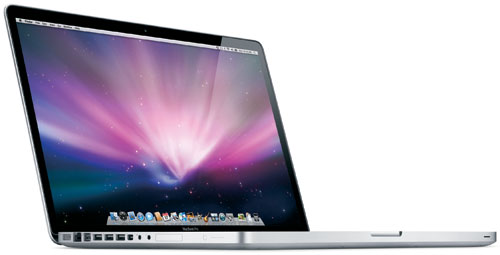Hosted by site sponsor WebMate.
Unibody MacBook Pro Q&A
Published March 14, 2009
All Mac Q&As >> Unibody MacBook Pro Q&A | Also See: All MacBook Pro Specs
To be notified of new Q&As, sign up for EveryMac.com's bimonthly email list.
How much faster is the "Early 2009" 17-Inch "Unibody" MacBook Pro Core 2 Duo than the "Early 2008/Penryn" 17-Inch MacBook Pro that it replaced? How fast is it compared to the 15-Inch "Unibody" MacBook Pro models?
Please note that all MacBook Pro models mentioned in this Q&A have been discontinued. However, this Q&A is up-to-date and quite useful for anyone considering one of these notebooks on the used market.
Quickly review a comparison of the "Early 2009" 17-Inch "Unibody" MacBook Pro Core 2 Duo -- the MacBook Pro "Core 2 Duo" 2.66 17-Inch (Early 2009/Unibody) -- to the "Early 2008/Penryn" model that it replaced -- the MacBook Pro "Core 2 Duo" 2.5 17-Inch (Early 2008/Penryn) -- and it is clear that the "Unibody" has improvements in design and architecture.

Photo Credit: Apple, Inc (Early 2009 17-Inch MacBook Pro)
Architecturally, the "Early 2009" system has a faster 45 nm "Penryn" Intel "Core 2 Duo" processor -- by default, 2.66 GHz up from 2.5 GHz -- and uses a faster architecture with a faster system bus -- 1066 MHz up from 800 MHz -- faster memory -- 1066 MHz PC3-8500 DDR3 compared to 667 MHz PC2-5300 DDR2 -- and faster and dual graphics processors -- a NVIDIA GeForce 9600M GT with dedicated GDDR3 SDRAM and a NVIDIA GeForce 9400M with 256 MB of DDR3 SDRAM shared with main memory compared to a single NVIDIA GeForce 8600M GT in the replaced model.
Compare the 17-Inch "Early 2009" model to the 15-Inch "Late 2008/Unibody" models, on the other hand, and one will notice that they all effectively use the same architecture.
With a slightly faster processor and a faster architecture, one should expect modest, but notable, performance differences between the 17-Inch "Early 2009" model and the model it replaced. As they effectively share the same architecture, there should be little to no difference in performance between the 17-Inch "Early 2009" model and the 15-Inch "Late 2008/Unibody" models.
Real-World Performance Tests
For the precise performance differences, however, real-world testing is required.
In its industry-standard Speedmark 5 benchmark, MacWorld reported in a series of test results:
As you'd expect, with a slightly faster processor, the new 17-inch MacBook Pro outperformed its predecessor, but just a tad; the new system was about 1.8 percent faster in our all-around system performance tool, Speedmark 5. Most tests, however, like Photo[s]hop, iMovie and iTunes were all within a second or two of each other. . .
Comparing the new 17-inch MacBook Pro to the [Unibody] 2.53 GHz 15-inch MacBook Pro. . . In our Speedmark testing, the 17-inch model only beat the top of the line 15-inch model in two test[s], our Cinema 4D render test and Quake frame rate scores.
Although the differences would be far more substantial in tests focused on 3D graphics (such as gaming), LaptopMag compared the two different graphics systems in the 17-Inch "Early 2009" system and noted:
We used Handbrake to transcode a 2-minute-and-17-second MPEG-4 clip with both integrated [9400M] and discrete [9600M GT] graphics enabled. With integrated graphics it took 2 minutes and 20 seconds; with discrete, 2:19. When running a DVD in the background, it took 2:33 with the integrated card and 2:30 with the discrete.
By running the XBench benchmark program -- which takes the processor, graphics, memory, and hard drive into account and generates an overall score -- Computerworld found:
The score for the [Early 2009 17-Inch] MacBook Pro topped out at 189. Fast. Very fast. (By way of comparison, my Air returned an Xbench score of 141. That 2007 MacBook Pro with a 2.4 GHz Core 2 Duo processor -- the top-of-the-line model two years ago -- got a score of 118.)
In their own reviews, Engadget, Gizmodo, and Reg Hardware also ran XBench tests on the 17-Inch "Early 2009" MacBook Pro compared to an assortment of other Macs and you may wish to peruse these results as well.
Performance Summary
Ultimately, the 17-Inch "Early 2009" MacBook Pro is modestly faster than its predecessor in most tasks and roughly comparable in performance to the 15-Inch "Late 2008/Unibody" models.
In the US, site sponsor Other World Computing sells used and refurb MacBook Pro models at bargain prices with free shipping, as well. On the other hand, if you need to sell a MacBook Pro, A+ BBB-rated Cash for Your Mac and GoRoostr will buy your older notebook with an instant quote and prompt payment.
In the UK, site sponsor Hoxton Macs sells used MacBook Pro models with a one-year warranty and free next day delivery throughout the UK. Delivery across Europe also is available starting at just £9.99 for two-day delivery to France and Germany.
Permalink | Report an Error/Typo | Sign Up for Site Update Notices
<< Unibody MacBook Pro Q&A (Main) | Also See: All MacBook Pro Specs
Established in 1996, EveryMac.com has been created by experts with decades of experience with Apple hardware. EveryMac.com includes, and always has included, original research incorporating detailed, hands-on inspection of packaging, computers, and devices as well as extensive real-world use. All information is provided in good faith, but no website or person is perfect. Accordingly, EveryMac.com is provided "as is" without warranty of any kind whatsoever. EveryMac.com, and the authors thereof, shall not be held responsible or liable, under any circumstances, for any damages resulting from the use or inability to use the information within. For complete disclaimer and copyright information please read and understand the Terms of Use and the Privacy Policy before using EveryMac.com. Copying, scraping, or use of any content without expressed permission is not allowed, although links to any page are welcomed and appreciated.
